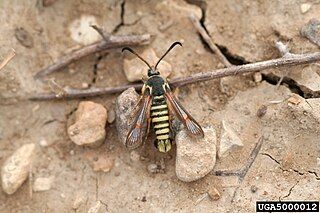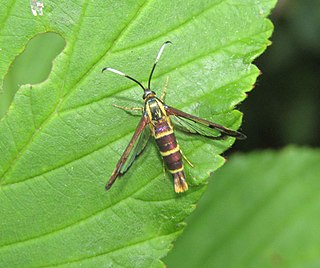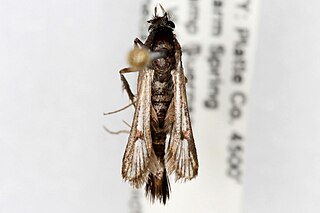
Carmenta mimuli, the coronopus borer, is a moth of the family Sesiidae. The dark form is the typical form and is found in Arizona. The whitish form is non-typical and is known from the south-western United States, from Kansas to Arizona.
Carmenta albociliata is a moth of the family Sesiidae. It was described by Engelhardt in 1925. It is known from North America, including Texas and Arizona.
Carmenta anthracipennis, the liatris borer moth, is a moth of the family Sesiidae. It was described by Jean Baptiste Boisduval in 1875, and is known from the United States, including Florida, Texas, Massachusetts and Illinois.
Carmenta auritincta, the Arizona clearwing moth, is a moth of the family Sesiidae. It was described by Engelhardt in 1925. It is known from south-eastern Arizona and northern Mexico.

Carmenta bassiformis, the eupatorium borer moth, is a moth of the family Sesiidae. It was described by Francis Walker in 1856, and is found in the United States from Massachusetts to Florida, west to Wisconsin, Kansas and Texas.
Carmenta engelhardti is a moth of the family Sesiidae. It was described by W. Donald Duckworth and Thomas Drake Eichlin in 1973. It is known from Arizona in the United States.
Carmenta mariona is a moth of the family Sesiidae. It was described by William Beutenmüller in 1900. It is found in the United States from Montana, south to Arizona and east to Kansas.
Carmenta odda is a moth of the family Sesiidae. It was described by W. Donald Duckworth and Thomas Drake Eichlin in 1977. It is found in the United States from South Carolina to Florida.
Carmenta ogalala is a moth of the family Sesiidae. It was described by Engelhardt in 1946. It is known from Colorado.
Carmenta phoradendri, the mistletoe borer, is a moth of the family Sesiidae. It was described by George Paul Engelhardt in 1946. It is known from south-eastern Arizona and southern Texas in the United States and from Mexico.
Carmenta rubricincta is a moth of the family Sesiidae. It was described by William Beutenmüller in 1909. It is known from North America, including Arizona.
Carmenta suffusata is a moth of the family Sesiidae. It was described by George Paul Engelhardt in 1946. It is known from the United States, including Florida, Oklahoma and Kansas.
Carmenta tecta, the mistletoe stem borer, is a moth of the family Sesiidae. It was described by Henry Edwards in 1882. It is known from the United States, including Arizona.
Carmenta texana, the Texana clearwing moth, is a moth of the family Sesiidae. It was described by Henry Edwards in 1881 and is known from the US states of Texas and Florida.

Carmenta verecunda is a moth of the family Sesiidae. It was described by Henry Edwards in 1881, and is known from the United States, including Colorado, Utah, California and Arizona.
Carmenta wellerae is a moth of the family Sesiidae. It was described by W. Donald Duckworth and Thomas Drake Eichlin in 1976. It is known from southern Arizona in the US and northern Mexico. The habitat consists of mountains and foothills.
Carmenta haematica, the Argentine root borer, is a moth of the family Sesiidae. It was described by Ureta in 1956, and is known from Argentina and Chile.
Carmenta theobromae, the cocoa fruit borer, is a moth of the family Sesiidae. It was described by August Busck in 1910, and is known from Colombia and Venezuela.
Carmenta laurelae is a moth of the family Sesiidae. It was described by Larry N. Brown, Thomas D. Eichlin and J. Wendell Snow in 1985, and is known from the US state of Florida.
BugGuide is a website and online community of naturalists, both amateur and professional, who share observations of insects, spiders, and other related creatures. The website consists of informational guide pages and many thousands of photographs of arthropods from the United States and Canada which are used for identification and research. The non-commercial site is hosted by the Iowa State University Department of Entomology. BugGuide was conceived by photographer Troy Bartlett in 2003 and since 2006 has been maintained by Dr. John VanDyk, Adjunct Assistant Professor of Entomology and Senior Systems Analyst at Iowa State University. The website has been recognized for helping change public perception of insects.


